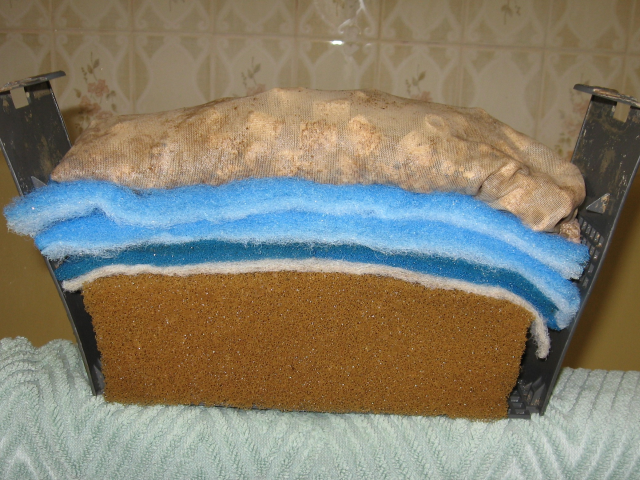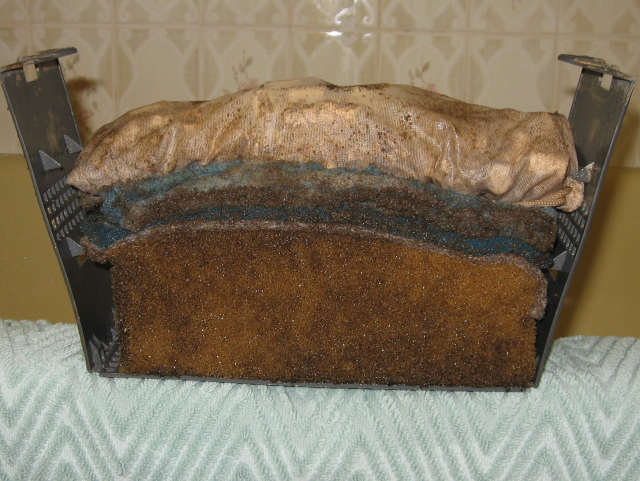A couple of things to note thus far.
Ten days ago I set up 3 glass storage containers, with each container holding just over a liter of distilled water. To which I then added 1 tablespoon of bacteria to the container on the left, and the middle, leaving the container on the far right with just distilled water. Once the dust settled a bit I added 6 large carnivorous pellets, that are high in protein & fat.
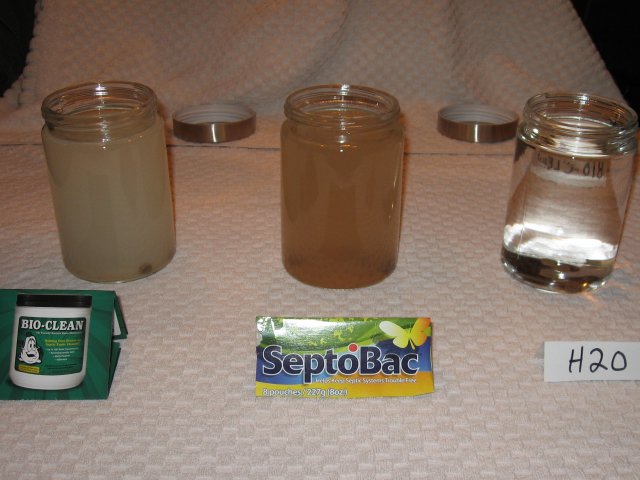
As you can see the Bio-Clean container had a more milky look to it, while the SeptoBac appears more brown. What you can't see in those pics is how much more soluble the Bio-Clean is. The SeptoBac left a thick layer of bran etc, that even after 10 days did not dissolve, or get digested. The little black balls found in the SeptoBac formula, were still there at the end of the 10 days. After reviewing the Safety Data Sheet for SeptoBac, I believe that those black "specks" listed under their color reference, are possibly pieces of Perlite. https://summitbrands.ca/wp-content/...atment-Septic-Pacs-English-GHS-Rev-12-....pdf
3. Composition/Information on Ingredients
Mixture
Chemical name: Citric Acid
CAS Number: 77-92-9 3-7
3-7%
Chemical name: Perlite, expanded
CAS Number: 93763-70-3
0.1-1.5%
All concentrations are in percent by weight unless ingredient is a gas. Gas concentrations are in percent by volume. US GHS: The exact percentage (concentration) of composition has been withheld as a trade secret in accordance with paragraph (i) of §1910.1200.
I could be wrong as there is no clarification from the manufacturer, but whatever it is it does not dissolve in solution, at least not in the short term. I have noticed this in my tanks as well, it gets sucked out during water changes.
Another thing that I noticed was over several days the SeptoBac container got a film on the surface, like pond scum. See below ...
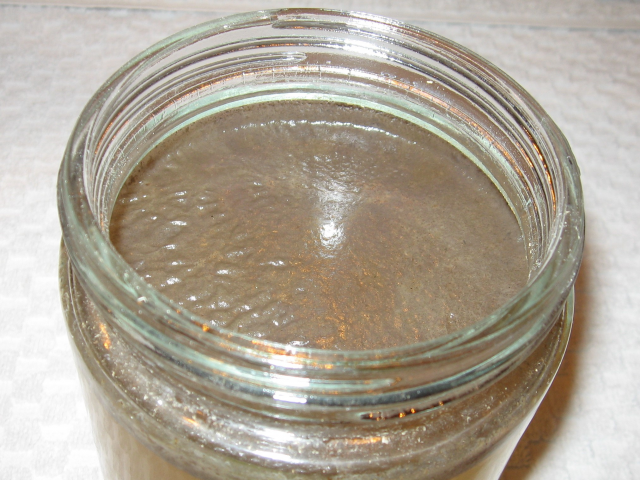
now the Bio-Clean after 10 days (no surface scum)
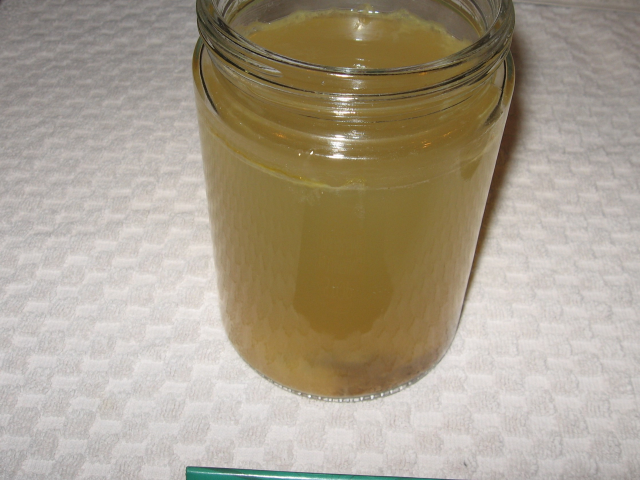
The biggest thing that I noticed, is that after 10 days the container treated with Bio-Clean was overall broken down into almost fine dust, and with no bran, "black specks" of whatever, and food break down, compared to the SeptoBac container. There were still "chunks" in both jars, but the Bio-Clean residual at the end of the 10 days was a LOT less than the SeptoBac container. It would have been an even better comparison to a closed system such as an aquarium, if I could have had air lines running in each container, but at the end of the day there is no doubt in my mind that the Bio-Clean was a cleaner way to go, and the digestion of the food seemed superior. It's far more soluble when compared to SeptoBac, and no doubt the same holds true for Rid-X from what I have read over the years. It sounds like Rid-X also contains a fair bit of bran etc as a medium.
Within 24 hrs of adding the fish food pellets, both containers that contained bacteria, had pellets that had now turned into crumble. The container with only water, the pellets all still retained their original shape. From what I have seen thus far it will be interesting to see how clean my filter media is with the Bio-Clean, vs what I have seen over the years using SeptoBac. The real test will be how small of a weekly dose I can use in the future as a maintenance dose in my tanks. I suspect as little as 1/4 teaspoon a week (or less!) of Bio-Clean per 125 gallons of tank will do the trick.
Ten days ago I set up 3 glass storage containers, with each container holding just over a liter of distilled water. To which I then added 1 tablespoon of bacteria to the container on the left, and the middle, leaving the container on the far right with just distilled water. Once the dust settled a bit I added 6 large carnivorous pellets, that are high in protein & fat.

As you can see the Bio-Clean container had a more milky look to it, while the SeptoBac appears more brown. What you can't see in those pics is how much more soluble the Bio-Clean is. The SeptoBac left a thick layer of bran etc, that even after 10 days did not dissolve, or get digested. The little black balls found in the SeptoBac formula, were still there at the end of the 10 days. After reviewing the Safety Data Sheet for SeptoBac, I believe that those black "specks" listed under their color reference, are possibly pieces of Perlite. https://summitbrands.ca/wp-content/...atment-Septic-Pacs-English-GHS-Rev-12-....pdf
3. Composition/Information on Ingredients
Mixture
Chemical name: Citric Acid
CAS Number: 77-92-9 3-7
3-7%
Chemical name: Perlite, expanded
CAS Number: 93763-70-3
0.1-1.5%
All concentrations are in percent by weight unless ingredient is a gas. Gas concentrations are in percent by volume. US GHS: The exact percentage (concentration) of composition has been withheld as a trade secret in accordance with paragraph (i) of §1910.1200.
I could be wrong as there is no clarification from the manufacturer, but whatever it is it does not dissolve in solution, at least not in the short term. I have noticed this in my tanks as well, it gets sucked out during water changes.
Another thing that I noticed was over several days the SeptoBac container got a film on the surface, like pond scum. See below ...

now the Bio-Clean after 10 days (no surface scum)

The biggest thing that I noticed, is that after 10 days the container treated with Bio-Clean was overall broken down into almost fine dust, and with no bran, "black specks" of whatever, and food break down, compared to the SeptoBac container. There were still "chunks" in both jars, but the Bio-Clean residual at the end of the 10 days was a LOT less than the SeptoBac container. It would have been an even better comparison to a closed system such as an aquarium, if I could have had air lines running in each container, but at the end of the day there is no doubt in my mind that the Bio-Clean was a cleaner way to go, and the digestion of the food seemed superior. It's far more soluble when compared to SeptoBac, and no doubt the same holds true for Rid-X from what I have read over the years. It sounds like Rid-X also contains a fair bit of bran etc as a medium.
Within 24 hrs of adding the fish food pellets, both containers that contained bacteria, had pellets that had now turned into crumble. The container with only water, the pellets all still retained their original shape. From what I have seen thus far it will be interesting to see how clean my filter media is with the Bio-Clean, vs what I have seen over the years using SeptoBac. The real test will be how small of a weekly dose I can use in the future as a maintenance dose in my tanks. I suspect as little as 1/4 teaspoon a week (or less!) of Bio-Clean per 125 gallons of tank will do the trick.
Last edited:


